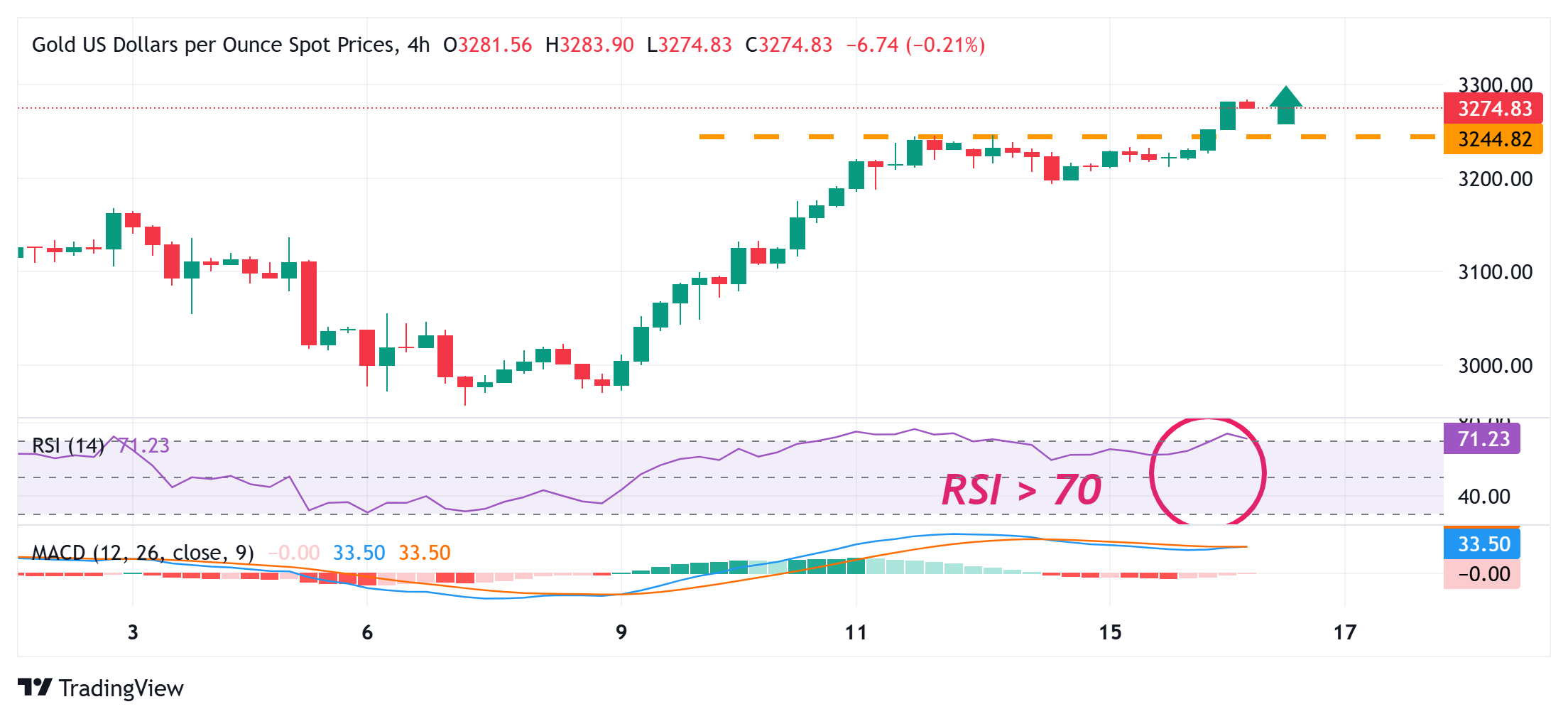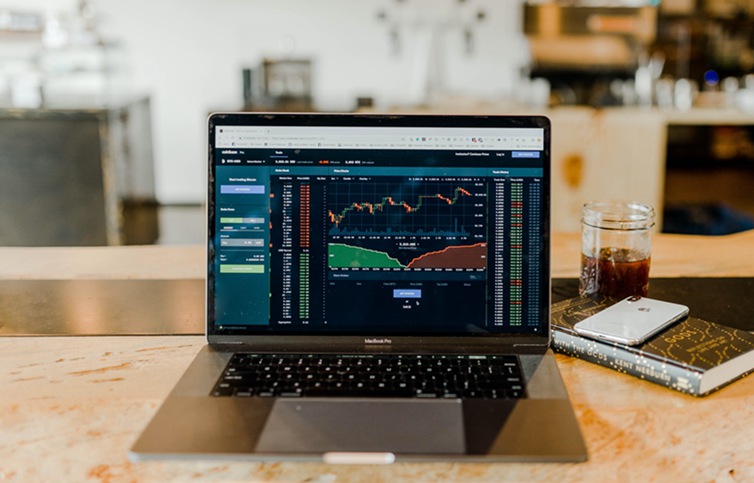Gold price buying remains unabated; fresh all-time high and counting amid trade jitters

- Gold price continues to attract safe-haven flows amid persistent trade-related uncertainties.
- Bets for aggressive policy easing by the Fed and a weaker USD also benefit the XAU/USD pair.
- Investors now look forward to Fed Chair Jerome Powell’s speech for some meaningful impetus.
Gold price (XAU/USD) scales higher for the second straight day on Wednesday – also marking the fifth day of a positive move in the previous six – and touches a fresh record high, around the $3,283-3,284 area during the Asian session. The initial market reaction to US President Donald Trump's decision last week to pause reciprocal tariffs for 90 days fades rather quickly amid rapid shifts in policy announcements. Furthermore, investors remain worried about the potential economic fallout amid the ongoing US tariff chaos, which continues to underpin demand for the traditional safe-haven precious metal.
Apart from this, expectations for a more aggressive policy easing by the Federal Reserve (Fed) in 2025 turn out to be another factor that benefits the non-yielding Gold price. Meanwhile, the US Dollar (USD) languishes near its lowest level since April 2022 touched last week amid the reduced faith in US policymakers and the weakening confidence in the US economy. This contributes to driving flows towards the XAU/USD and remains supportive of the positive momentum, which seems rather unaffected by overbought conditions. Investors now look forward to comments from Fed Chair Jerome Powell.
Daily Digest Market Movers: Gold price prolongs its uptrend as US tariff jitters boost safe-haven demand
- US President Donald Trump took a U-turn last week and abruptly backed off his hefty reciprocal tariffs on most US trading partners for 90 days. Moreover, Trump suggested that he might grant exemptions on auto-related levies after removing smartphones, computers, and some other electronics from steep tariffs on China.
- Trump, however, said that exemptions were only temporary and kept in place 145% duties on other Chinese imports. Trump further promised to unveil tariffs on imported semiconductors over the next week and also threatened that he would impose levies on pharmaceuticals in the not-too-distant future, raising uncertainty.
- China, on the other hand, increased its tariffs on US imports to 125% last Friday, fueling concerns that a tit-for-tat trade war between the world's two largest economies would weaken global growth. This continues to weigh on investors' sentiment and benefits safe-haven assets, lifting the Gold price to a fresh record high on Wednesday.
- Meanwhile, Trump's rapid shifts in tariff announcements have eroded investors' faith in US policies and weakened confidence in the US economy. Adding to this, bets that the Federal Reserve (Fed) will lower borrowing costs by 100 basis points in 2025 sent the US Dollar sharply lower, to its lowest level since April 2022 last week.
- Data released earlier this Wednesday showed that China's economy grew 5.4% in the first quarter from a year earlier, beating expectations. Other Chinese macro data – Retail Sales, Industrial Production, and Fixed Asset Investment – also came in better than estimates, though it was overshadowed by rising trade tensions with the US.
- Investors now await comments from Fed Chair Jerome Powell for more clues on the interest rate path, which will play a key role in influencing the USD price dynamics. Apart from this, trade-related developments should provide some meaningful impetus to the XAU/USD pair, which seems poised to prolong the uptrend.
Gold price bulls might wait for some consolidation or modest pullback before placing fresh bets amid an overbought RSI

From a technical perspective, the Relative Strength Index (RSI) on daily/4-hour charts is flashing slightly overbought conditions and warrants some caution for bullish traders. Hence, it will be prudent to wait for some near-term consolidation or a modest pullback before positioning for any further appreciating move for the Gold price.
In the meantime, any corrective pullback might now find some support near the $3,246-3,245 area ahead of the Asian session low, around the $3,230-3,229 region. Any further slide, however, might still be seen as a buying opportunity and is more likely to remain limited ahead of the $3,200 round-figure mark.
Gold FAQs
Gold has played a key role in human’s history as it has been widely used as a store of value and medium of exchange. Currently, apart from its shine and usage for jewelry, the precious metal is widely seen as a safe-haven asset, meaning that it is considered a good investment during turbulent times. Gold is also widely seen as a hedge against inflation and against depreciating currencies as it doesn’t rely on any specific issuer or government.
Central banks are the biggest Gold holders. In their aim to support their currencies in turbulent times, central banks tend to diversify their reserves and buy Gold to improve the perceived strength of the economy and the currency. High Gold reserves can be a source of trust for a country’s solvency. Central banks added 1,136 tonnes of Gold worth around $70 billion to their reserves in 2022, according to data from the World Gold Council. This is the highest yearly purchase since records began. Central banks from emerging economies such as China, India and Turkey are quickly increasing their Gold reserves.
Gold has an inverse correlation with the US Dollar and US Treasuries, which are both major reserve and safe-haven assets. When the Dollar depreciates, Gold tends to rise, enabling investors and central banks to diversify their assets in turbulent times. Gold is also inversely correlated with risk assets. A rally in the stock market tends to weaken Gold price, while sell-offs in riskier markets tend to favor the precious metal.
The price can move due to a wide range of factors. Geopolitical instability or fears of a deep recession can quickly make Gold price escalate due to its safe-haven status. As a yield-less asset, Gold tends to rise with lower interest rates, while higher cost of money usually weighs down on the yellow metal. Still, most moves depend on how the US Dollar (USD) behaves as the asset is priced in dollars (XAU/USD). A strong Dollar tends to keep the price of Gold controlled, whereas a weaker Dollar is likely to push Gold prices up.





